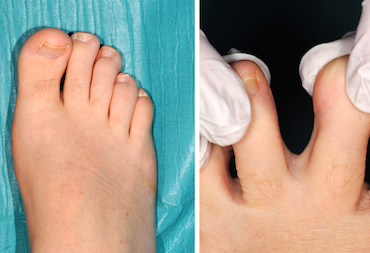ZYGODACTYLY IS STRONGLY ASSOCIATED WITH ACUTE MYELOID LEUKAEMIA
(Abstract release date: 05/19/16)
EHA Library. Niblock A. 06/09/16; 132476; E927

Dr. Aaron Niblock
Contributions
Contributions
Abstract
Abstract: E927
Type: Eposter Presentation
Background
Zygodactyly is a subtype of syndactyly characteristed by bilateral partial cutaneous webbing of the second and third toes without hand involvement. It is a failure in separation of developing toes during organogenesis. The incidence of zygodactyly is approximately 4 in 10,000 men and males are affected twice as frequently as females1. In Northern Ireland there are 3.3 per 100,000 new cases of Acute Myeloid Leukaemia (AML) each year2Podiatry assessment of two haematology ward patients with AML confirmed zygodactyly. Given its relatively low incidence in the general population we decided to inspect all our inpatients.
Aims
To assess if there is a correlation between patients with zygodactyly and the development of acute leukaemia.
Methods
On the 18th January 2016, all the inpatients with acute leukaemia were examined by a physician and a podiatrist for presence or absence of zygodactyly. There were 17 patients in total (7 male, 10 female).
Results
14 out of 17 had partial or full zygodactyly and AML (figure 1). In the unaffected group one patient had Acute Lymphoblastic Leukaemia (ALL), two had AML (one of whom had Acute pro-myelocytic leukaemia). This ward based observational case series interestingly shows a higher frequency of Zygodactyly amongst patients with AML. It also demonstrated no particular sex predominance which one usually attributes to Zygodactyly. This raises the question of way subtle 2nd/3rd toe syndactyly is higher amongst patients with acute myeloid leukaemia?
Conclusion
It is not unusual for physical abnormalities to be associated with an increased risk of developing AML. Congenital bone marrow failure syndromes demonstrate multisystemic abnormalities and a risk of AML in later life. Diamond Blackfan anaemia has physical abnormalities (~50%) including webbed neck, malformed thumbs and 5% develop AML. Over 50% of Fanconi anaemia cases have skeletal abnormalities especially the radial ray - 10-20% develop Myelodysplastic syndrome/AML over a 13 year period. Dyskeratosis Congenita is characteristed by the association of dyskeratotic nails and bone marrow failure with a signifcant increase in AML3. Case reports show these syndromes are occasionally diagnosed in the 3rd and 4th decades as clinical features are occasionally subtle.AML arises from genetic alterations in a stem or progenitor cell that result inuncontrolled growth. The hematopoietic microenvironment has been implicated in the pathogenesis of hematologic malignancies. Hematopoietic stem cells live in a highly specialized complex microenvironment, known as a niche4. The structures common to bone marrow environment and cutaneous tissues could help explain the link between physical abnormalities and the risk of AML. Zygodactyly subtype 1 (ZD1) has been linked to chromosome 3p21.31 so genes in this region may be associated with AML or may modify the niche. Further studies are needed to determine the exact causes of this interesting finding

Session topic: E-poster
Type: Eposter Presentation
Background
Zygodactyly is a subtype of syndactyly characteristed by bilateral partial cutaneous webbing of the second and third toes without hand involvement. It is a failure in separation of developing toes during organogenesis. The incidence of zygodactyly is approximately 4 in 10,000 men and males are affected twice as frequently as females1. In Northern Ireland there are 3.3 per 100,000 new cases of Acute Myeloid Leukaemia (AML) each year2Podiatry assessment of two haematology ward patients with AML confirmed zygodactyly. Given its relatively low incidence in the general population we decided to inspect all our inpatients.
Aims
To assess if there is a correlation between patients with zygodactyly and the development of acute leukaemia.
Methods
On the 18th January 2016, all the inpatients with acute leukaemia were examined by a physician and a podiatrist for presence or absence of zygodactyly. There were 17 patients in total (7 male, 10 female).
Results
14 out of 17 had partial or full zygodactyly and AML (figure 1). In the unaffected group one patient had Acute Lymphoblastic Leukaemia (ALL), two had AML (one of whom had Acute pro-myelocytic leukaemia). This ward based observational case series interestingly shows a higher frequency of Zygodactyly amongst patients with AML. It also demonstrated no particular sex predominance which one usually attributes to Zygodactyly. This raises the question of way subtle 2nd/3rd toe syndactyly is higher amongst patients with acute myeloid leukaemia?
Conclusion
It is not unusual for physical abnormalities to be associated with an increased risk of developing AML. Congenital bone marrow failure syndromes demonstrate multisystemic abnormalities and a risk of AML in later life. Diamond Blackfan anaemia has physical abnormalities (~50%) including webbed neck, malformed thumbs and 5% develop AML. Over 50% of Fanconi anaemia cases have skeletal abnormalities especially the radial ray - 10-20% develop Myelodysplastic syndrome/AML over a 13 year period. Dyskeratosis Congenita is characteristed by the association of dyskeratotic nails and bone marrow failure with a signifcant increase in AML3. Case reports show these syndromes are occasionally diagnosed in the 3rd and 4th decades as clinical features are occasionally subtle.AML arises from genetic alterations in a stem or progenitor cell that result inuncontrolled growth. The hematopoietic microenvironment has been implicated in the pathogenesis of hematologic malignancies. Hematopoietic stem cells live in a highly specialized complex microenvironment, known as a niche4. The structures common to bone marrow environment and cutaneous tissues could help explain the link between physical abnormalities and the risk of AML. Zygodactyly subtype 1 (ZD1) has been linked to chromosome 3p21.31 so genes in this region may be associated with AML or may modify the niche. Further studies are needed to determine the exact causes of this interesting finding

Session topic: E-poster
Abstract: E927
Type: Eposter Presentation
Background
Zygodactyly is a subtype of syndactyly characteristed by bilateral partial cutaneous webbing of the second and third toes without hand involvement. It is a failure in separation of developing toes during organogenesis. The incidence of zygodactyly is approximately 4 in 10,000 men and males are affected twice as frequently as females1. In Northern Ireland there are 3.3 per 100,000 new cases of Acute Myeloid Leukaemia (AML) each year2Podiatry assessment of two haematology ward patients with AML confirmed zygodactyly. Given its relatively low incidence in the general population we decided to inspect all our inpatients.
Aims
To assess if there is a correlation between patients with zygodactyly and the development of acute leukaemia.
Methods
On the 18th January 2016, all the inpatients with acute leukaemia were examined by a physician and a podiatrist for presence or absence of zygodactyly. There were 17 patients in total (7 male, 10 female).
Results
14 out of 17 had partial or full zygodactyly and AML (figure 1). In the unaffected group one patient had Acute Lymphoblastic Leukaemia (ALL), two had AML (one of whom had Acute pro-myelocytic leukaemia). This ward based observational case series interestingly shows a higher frequency of Zygodactyly amongst patients with AML. It also demonstrated no particular sex predominance which one usually attributes to Zygodactyly. This raises the question of way subtle 2nd/3rd toe syndactyly is higher amongst patients with acute myeloid leukaemia?
Conclusion
It is not unusual for physical abnormalities to be associated with an increased risk of developing AML. Congenital bone marrow failure syndromes demonstrate multisystemic abnormalities and a risk of AML in later life. Diamond Blackfan anaemia has physical abnormalities (~50%) including webbed neck, malformed thumbs and 5% develop AML. Over 50% of Fanconi anaemia cases have skeletal abnormalities especially the radial ray - 10-20% develop Myelodysplastic syndrome/AML over a 13 year period. Dyskeratosis Congenita is characteristed by the association of dyskeratotic nails and bone marrow failure with a signifcant increase in AML3. Case reports show these syndromes are occasionally diagnosed in the 3rd and 4th decades as clinical features are occasionally subtle.AML arises from genetic alterations in a stem or progenitor cell that result inuncontrolled growth. The hematopoietic microenvironment has been implicated in the pathogenesis of hematologic malignancies. Hematopoietic stem cells live in a highly specialized complex microenvironment, known as a niche4. The structures common to bone marrow environment and cutaneous tissues could help explain the link between physical abnormalities and the risk of AML. Zygodactyly subtype 1 (ZD1) has been linked to chromosome 3p21.31 so genes in this region may be associated with AML or may modify the niche. Further studies are needed to determine the exact causes of this interesting finding

Session topic: E-poster
Type: Eposter Presentation
Background
Zygodactyly is a subtype of syndactyly characteristed by bilateral partial cutaneous webbing of the second and third toes without hand involvement. It is a failure in separation of developing toes during organogenesis. The incidence of zygodactyly is approximately 4 in 10,000 men and males are affected twice as frequently as females1. In Northern Ireland there are 3.3 per 100,000 new cases of Acute Myeloid Leukaemia (AML) each year2Podiatry assessment of two haematology ward patients with AML confirmed zygodactyly. Given its relatively low incidence in the general population we decided to inspect all our inpatients.
Aims
To assess if there is a correlation between patients with zygodactyly and the development of acute leukaemia.
Methods
On the 18th January 2016, all the inpatients with acute leukaemia were examined by a physician and a podiatrist for presence or absence of zygodactyly. There were 17 patients in total (7 male, 10 female).
Results
14 out of 17 had partial or full zygodactyly and AML (figure 1). In the unaffected group one patient had Acute Lymphoblastic Leukaemia (ALL), two had AML (one of whom had Acute pro-myelocytic leukaemia). This ward based observational case series interestingly shows a higher frequency of Zygodactyly amongst patients with AML. It also demonstrated no particular sex predominance which one usually attributes to Zygodactyly. This raises the question of way subtle 2nd/3rd toe syndactyly is higher amongst patients with acute myeloid leukaemia?
Conclusion
It is not unusual for physical abnormalities to be associated with an increased risk of developing AML. Congenital bone marrow failure syndromes demonstrate multisystemic abnormalities and a risk of AML in later life. Diamond Blackfan anaemia has physical abnormalities (~50%) including webbed neck, malformed thumbs and 5% develop AML. Over 50% of Fanconi anaemia cases have skeletal abnormalities especially the radial ray - 10-20% develop Myelodysplastic syndrome/AML over a 13 year period. Dyskeratosis Congenita is characteristed by the association of dyskeratotic nails and bone marrow failure with a signifcant increase in AML3. Case reports show these syndromes are occasionally diagnosed in the 3rd and 4th decades as clinical features are occasionally subtle.AML arises from genetic alterations in a stem or progenitor cell that result inuncontrolled growth. The hematopoietic microenvironment has been implicated in the pathogenesis of hematologic malignancies. Hematopoietic stem cells live in a highly specialized complex microenvironment, known as a niche4. The structures common to bone marrow environment and cutaneous tissues could help explain the link between physical abnormalities and the risk of AML. Zygodactyly subtype 1 (ZD1) has been linked to chromosome 3p21.31 so genes in this region may be associated with AML or may modify the niche. Further studies are needed to determine the exact causes of this interesting finding

Session topic: E-poster
{{ help_message }}
{{filter}}


